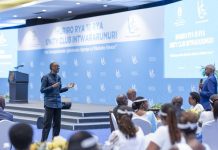Peter Ruti
Africa-Press – Rwanda. In the previous article in the series, we observed how the regime of President Juvenal Habyarimana used political polarisation as a weapon to block the process of peace negotiations with the opposition that included the RPF-Inkotanyi. It did that by radicalising ethnic identities and mobilising the population using stereotypes that denounced the enemy of the “Hutu” people. In this piece, we shall realise how resistance to such manipulations ushered in the signing of the Arusha Accords.
The period agreed upon to put in place transitional institutions was 37 days after signing the agreement. That period was not observed for several reasons. From September 10, 1993, the country entered an institutional vacuum that the forces opposed to the agreement took advantage of to render the latter inoperable. Since the signing of the Arusha agreement on August 4, 1993, the government had only to handle day-to-day affairs. It was less efficient than the previous government due to the insecurity that was created by the Habyarimana camp, which was determined, more than ever, to fail the peace process.
The first problem hinged on the delayed deployment of UN forces (UNAMIR), whose arrival was expected on October 31, 1993. A joint RPF/government delegation crisscrossed some capitals of the West and went to the UN to sensitise the international community and world leaders on the necessity and urgency of the rapid deployment of a neutral international force before establishing the transitional institutions.
In September, soon-to-be UNAMIR Force Commander, Gen Romeo Dallaire, said in his report that conditions had been met for the arrival of the Blue Helmets. On October 5, 1993, the Security Council unanimously approved Resolution 872 on the deployment of 2,500 UNAMIR soldiers to maintain peace in Rwanda.
Their mission was to supervise the transition process up to the elections. It had a budget of $62.6 million. The deployment of these forces was supposed to be progressive and spread over three months after the approval of the Security Council. UNAMIR started its functions officially on November 1, 1993.
The second pretext for blockage by President Habyarimana and political parties that supported him was the discord and breakup of opposition parties that were invited to participate in the transitional government. Per the agreement, MDR, PSD, MRND, PL and other smaller parties had to hold elections of parliamentarians to the Transitional National Assembly as well as ministerial candidates of some parties like PSD. The choices made were not respected because of manipulations by the President.
From October 1993, MRND and CDR parties were involved in a series of violence and blockages, including massacres and assassinations. One example is the assassination of F. Gatabazi that took place on February 21, 1994. There was meddling in the problems of Burundi, taking advantage of divisions of some political parties and unauthorised demonstrations to prevent the swearing-in of ministers.
Whenever decisions related to the establishment of institutions were supposed to take place, violence and terrorism by the Interahamwe and CDR’s Impuzamugambi militias increased in intensity. In February 1994, the Rwandan army (FAR) laid an ambush against the RPA in which one person was killed and two were injured. It was intent on killing the RPF delegation, which should have taken the oath of office on a date that had been decreed unilaterally and illegally by President Habyarimana.
The objectives of these manoeuvres were, on the one hand, to deliberately prevent the Arusha Peace agreement from being completed by blocking the establishment of a transitional government and the Transitional National Assembly. The presidential camp openly asked for renewed negotiation of certain protocols and CDR’s representation in the National Assembly.
On the other hand, President Habyarimana wanted to tilt in his favour the balance of political forces projected in the Arusha Peace Accord. He made lists of Members of Parliament of his own choice with the complicity of some political leaders of PL, MDR, PDI and PDC who had changed camp. He deployed all his forces to have them sworn in.
RPF considered that situation unacceptable because it was a result of a climate of intimidation and terrorism contrary to the spirit and Arusha Protocols. RPF accused Habyarimana of manipulating political parties to have greater influence in the institutions of the transitional period.
In his capacity as President of the constitutional court, Joseph Kavaruganda submitted to the Prime Minister a list of recognised parties as well names of personalities who met the conditions that were required to enter the Transitional National Assembly.
Source: The New Times
For More News And Analysis About Rwanda Follow Africa-Press






